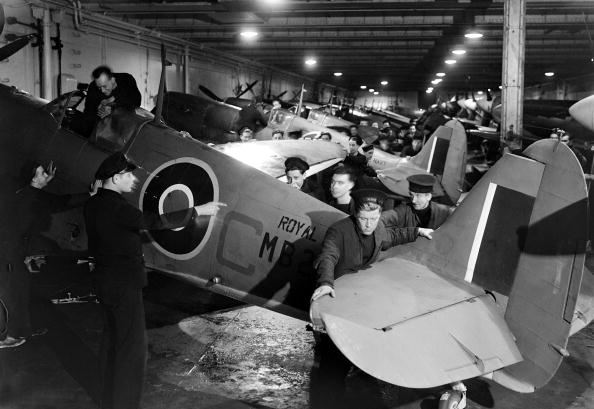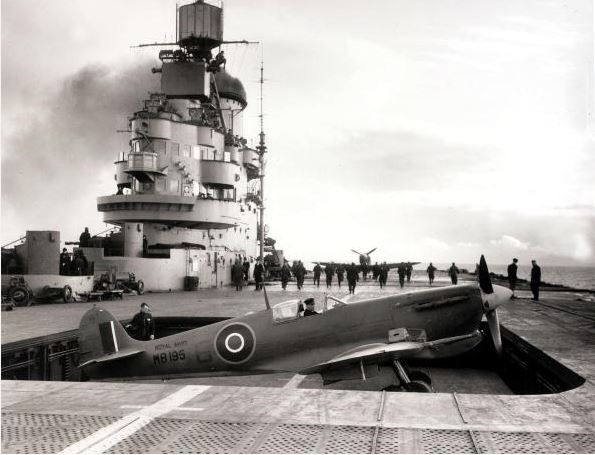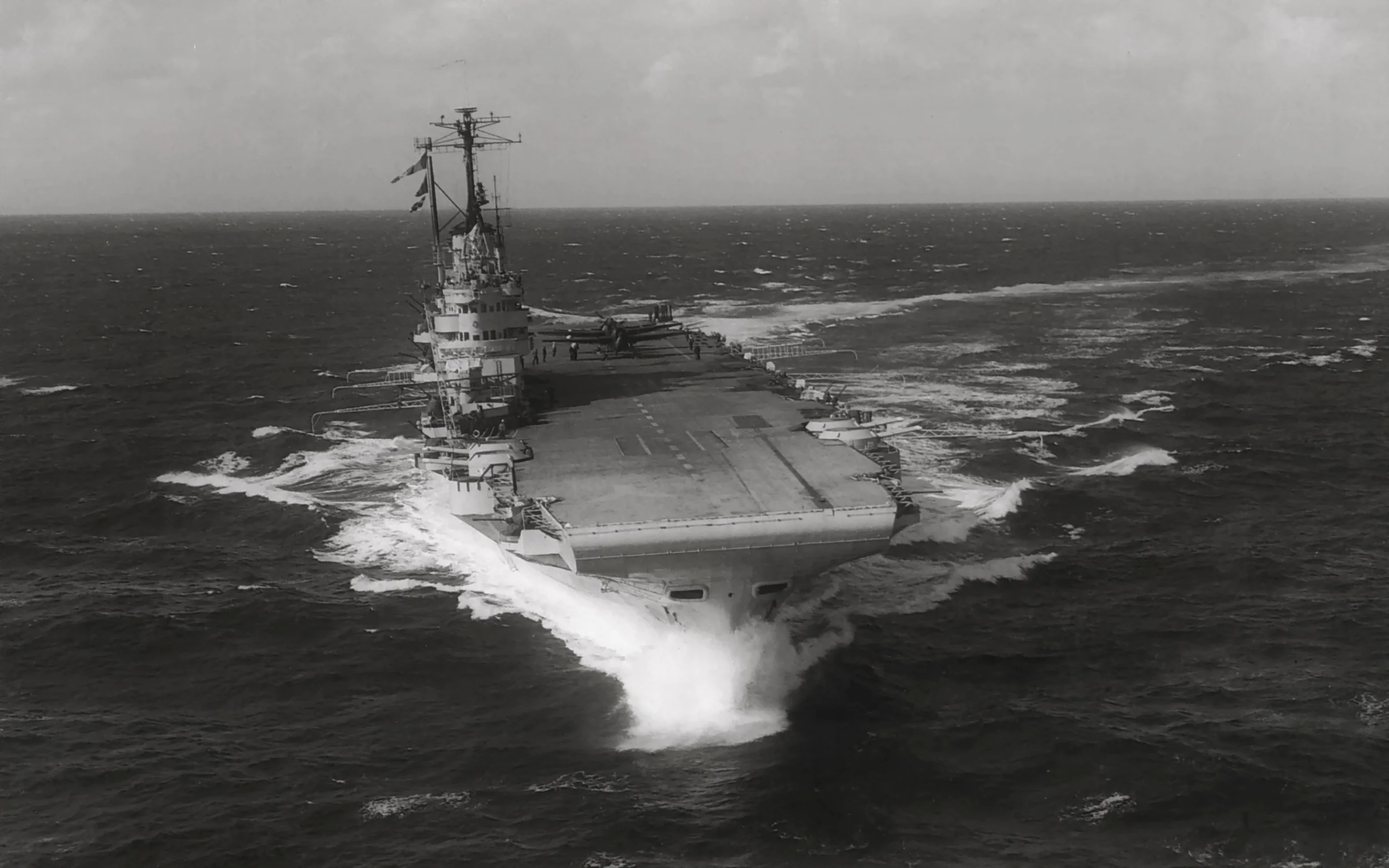By the time the fourth ship of the class was being laid down, the Royal Navy changed course: It still wanted heavily protected carriers, but it also wanted bigger air groups. Indomitable was to be the test-bed.
Click to enlarge
“At first it is all utterly baffling. The ship is so huge, and her geography so complex. One is continually losing oneself, drifting into seamen’s mess-decks, or the galleys, full of shining ovens and sweating cooks in soiled white aprons, or reaching dead ends, chilly metal corners smelling of potatoes, and lobbies smelling of hundred octane, facing time and time again the dilemma of the two alternative watertight doors and half-afraid to take off the clips— for fear of what? Of not being able to clamp them on again, of somehow endangering the ship, of being thrust back by a rearing wall of green water. … Any fantasy can sweat coldly to birth, like a mushroom, in those long, lit, empty, echoing, iron corridors. And the roaring air is electric with half-heard orders and shrill with bosun’s pipes, and brassy with bells and bugles.”
HMS Indomitable was the fourth ship of the Illustrious class to be laid down. But, shortly after work began in 1937, the doubts that had been afflicting the Admiralty about the size of the type’s air group finally spurred action.
A new requirement was issued: The ideal aircraft complement would now be 48.
Work on Indomitable had been delayed an estimated eight months due to delays in the production of armour plate in Czechoslovakia.
Britain’s own armour manufacturers, seriously depleted after the 1920s economic crisis, were simply unable to meet demand as the nation expanded production in preparation for war.
This delay provided an opportunity for the requirement which would produce Implacable and Indefatigable to be applied to one of the existing build orders.
The sting was in the tail of the requirement: This must be achieved on the same displacement.
Naval architects were put on the job. Their answer was the obvious one: An extra hangar deck could be inserted – if the top weight of armour could be counterbalanced. This could be achieved through substantially reducing the thickness of the armour plate on the hangar sides.
This was accepted and new drawings hurriedly produced for the shipyard.
The design, if something of a compromise, would produce what would become Britain’s most flexible and “useful” fleet carrier of the war.
Henry "Hank" Adlam: The Disastrous Fall and `Triumphant Rise of the Fleet Air Arm
However, there were certain disadvantages in their design and one of these, except for the larger ship Indomitable, was the very poor accommodation for junior aircrews. Another, and some would say one of greater significance, was the unnecessary provision of two 4.5 inch guns at each end of the flight deck. Each of these guns took a large amount of area below deck, which would have been better used as hangar space. These guns made an almighty loud cracking noise and this author has to confess being frightened out of his skin when one went off close to his aircraft while waiting with engine running to take off... These four naval guns on the Fleet Carriers were merely a silly waste of space which could have been made available for more aircraft, because aircraft provide the best defence against air or surface attack. And anyway, the battleships and cruisers were there to provide that type of defence fire, if needed. Other more minor disadvantages in these Fleet Carriers were lack of cool air conditioning for the tropics and insufficient fuel tankage for long-distance steaming. Both of these latter disadvantages stemmed from designing the ships for European waters only.
“The armoured table-top of the flight deck runs away for’ard and aft. It is bare but for the arrestor wires and the barriers that traverse it, and the innumerable ring-bolts for lashing down aircraft. Surrounding it for the greater part of its length are the nets, narrow walkways below the level of the deck-coaming where the flight deck party crouch out of the wind and where all manner of equipment from fire-extinguishers to chocks lives, or is slung.”
Flight Deck
While the original caption states this is HMS VICTORIOUS as seen from the island of INDOMITABLE during Operation PEDESTAL, the identities are likely the other way around. (Only VICTORIOUS had the raised deck faring behind the 4.5in turrets, seen here with crew standing on it)
Indomitable’s hull was five feet longer than in Illustrious. HMS Victorious was also given this extra hull length, but not the extra hangar deck.
Initially, Indomitable's effective deck length was 680ft. As with her half-sisters, though, the deck round-downs were gradually removed during wartime refits. For Indomitable, this resulted in 65ft of extra space for deck parks and landing/take-off operations.
The resulting flight deck length was 745ft, with an operational width of 95ft.
Non-folding Seafire IBs and IICs stowed within HMS INDOMITABLE's hangar in 1943.
“The upper hangar runs the length of the ship from lift to lift, a hollow-echoing steel box which is the headquarters of the squadrons’ non-flying activities. It is garage and workshop, with points for petrol, oil, compressed air and power for the tools; and about it, through innumerable watertight doors and lobbies, are grouped the endless cubby-holes that ships and squadrons need for their well-being: squadron stores, battery-charging rooms, blacksmith’s shop, paint-store, dope-store, bosun’s stores, engineering and electrical workshops and the squadron offices. It is two full decks high, and among the arrestor gear machinery in the deckhead are sprays that can flood it from end to end in case of fire. Spare mainplanes and propellers are clamped to the bulkheads like trophies.”
Hangars
Indomitable differed mainly from the Illustrious design in that she had an extra half-hangar. This space was actually what remained of the original Illustrious design’s hangar.
Its height remained the same 16ft as in Illustrious, but during the rework, its length was shortened to the rear half. What used to be the forward half of the hangar was redesigned for the extra accommodation and storage space needed for the larger air group.
A new - 416ft x 62ft - hangar was inserted above this deck. This was shorter than Illustrious by the equivalent of one stowage station (three aircraft abreast). This gave the upper hangar the pre-war standard stowage capacity of 30 aircraft while the lower (208ft by 62ft) had 15 stowage stations.
Top weight was still an issue, so the upper hangar was made somewhat lower at 14ft. The Admiralty deemed this reduced height was not to be a problem as all existing and projected British naval aircraft designs at that time used the rearward-hinging type of fold – not upward folding.
This 1937 perspective of the future would prove unfortunately limiting. By 1945 she was unable to fit Corsairs in the upper hangar. Instead, she was the only RN fleet carrier to operate the F6F Hellcat in large numbers.
“Our Hurricanes, having to go down the lift sideways on, are mounted on little trolleys which run on rails the full length of the hangar and on to the lift. This enables them to be pushed sideways up the hangar, straight on to the lift ready to be ranged. But there are only three sets of trolleys, so each aircraft has to be manhandled on to its trolley when it’s ranged, and manhandled off again when it’s struck down. The distance between the wingtip of one aircraft and the fuselage of the next is about a foot; between the elevators and the hangar bulkhead three inches or less; between our spinners and the Fulmars on the other side, perhaps three feet. So there isn’t much room to play about with.”
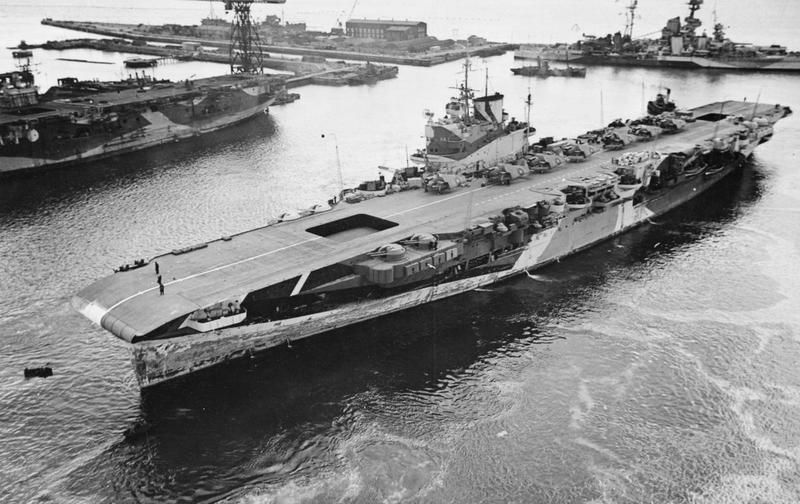
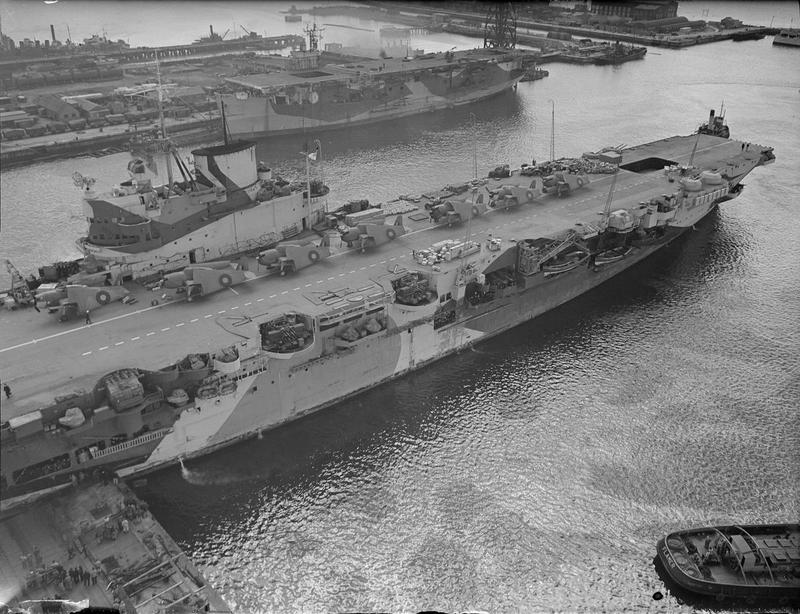
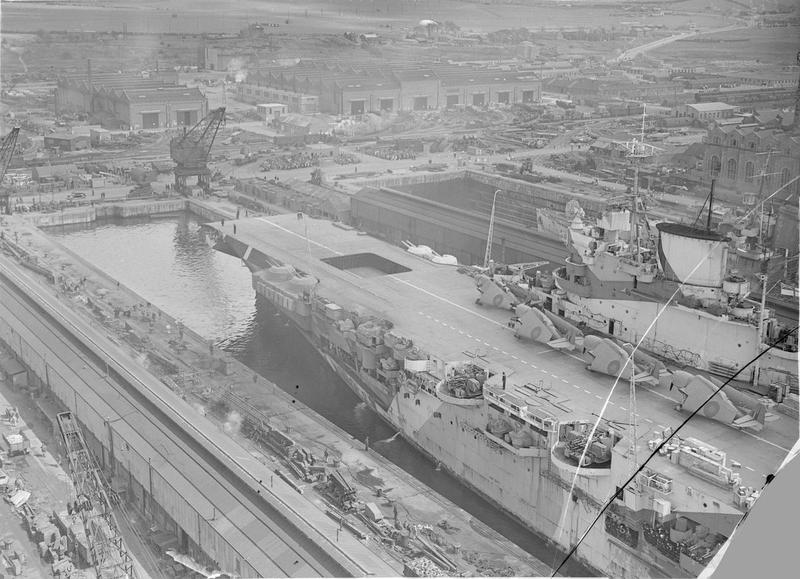
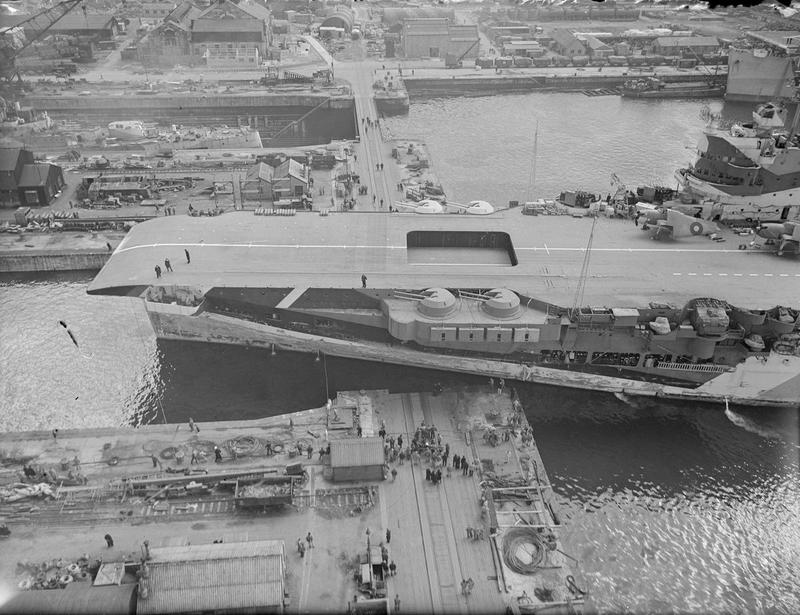
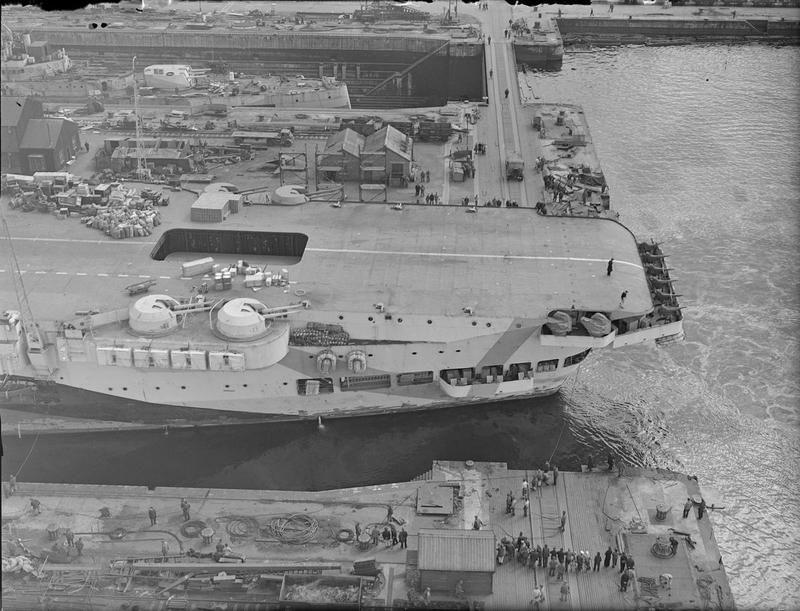
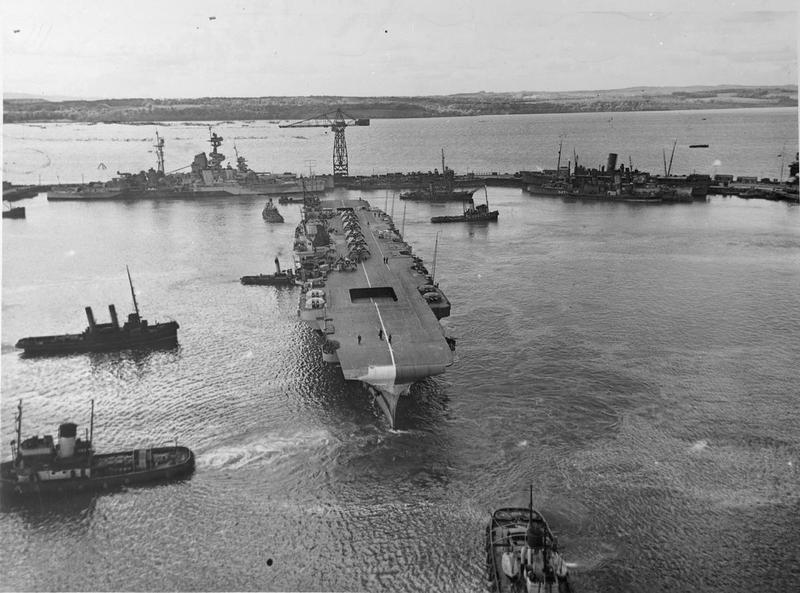
“There are two lifts. The for’ard is the only one big enough to take a Hurricane— and then only athwartships— and communicates with the upper hangar, which we share with the Fulmar Squadron and one of the two Albacore squadrons. The after-lift serves both upper and lower hangars.”
Lifts
Indomitable’s aft lift was the only lift that had access to both hangar decks. Post war, it would prove somewhat frustrating that this smaller 22ft by 45ft lift was the only access to the taller 16ft lower hangar.
The forward lift, however, was an important modification. It was increased in width to 33ft, allowing non-folding aircraft such as the Sea Hurricane, early Martlets and Seafires to be stowed in the main hangar. These aircraft would be moved off the lift and on to railed trolleys so they could be parked at an angle within the 14ft tall hangar space.
In July 1943, this lift enabled Indomitable to stow more than 40 non-folding Mk IIc and Mk L IIc Seafires for the covering force of Operation Husky, the invasion of Sicily.
The forward lift had been moved aft some 16ft and the aft lift forward by 24ft. Both lifts were designed to carry 14,000lb but were modified during construction for a 20,000lb load.
The forward lift cycle (one way loaded, return unloaded) was 26 seconds. The aft lift, cycling to the bottom hangar, could attain 43 seconds.
Accelerator
The accelerator was of a slightly upgraded design. Indomitable could launch 12,500lb at 66 knots. If using the trolley configuration, this was 14,000lb at 66 knots.
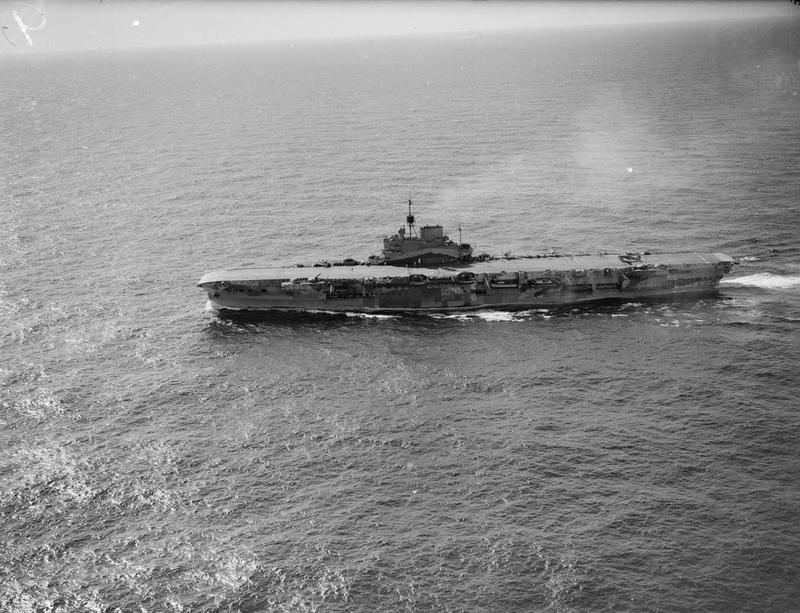
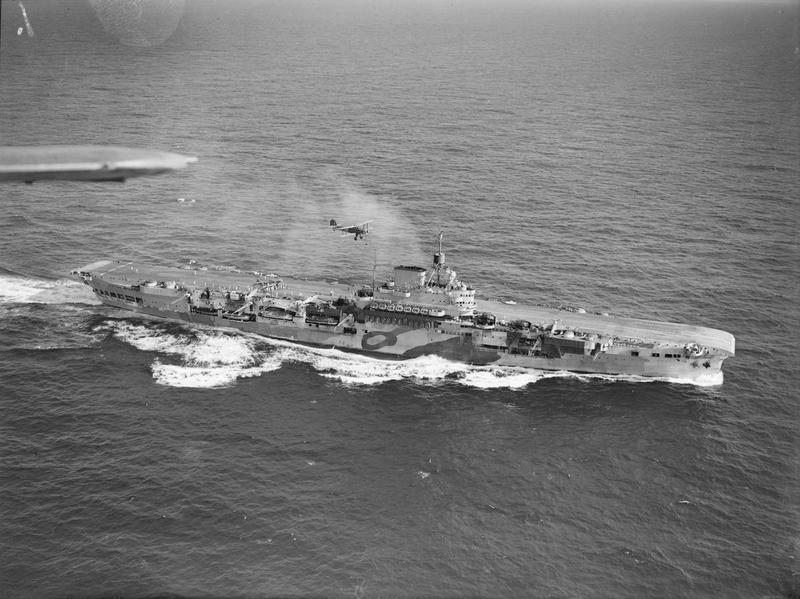
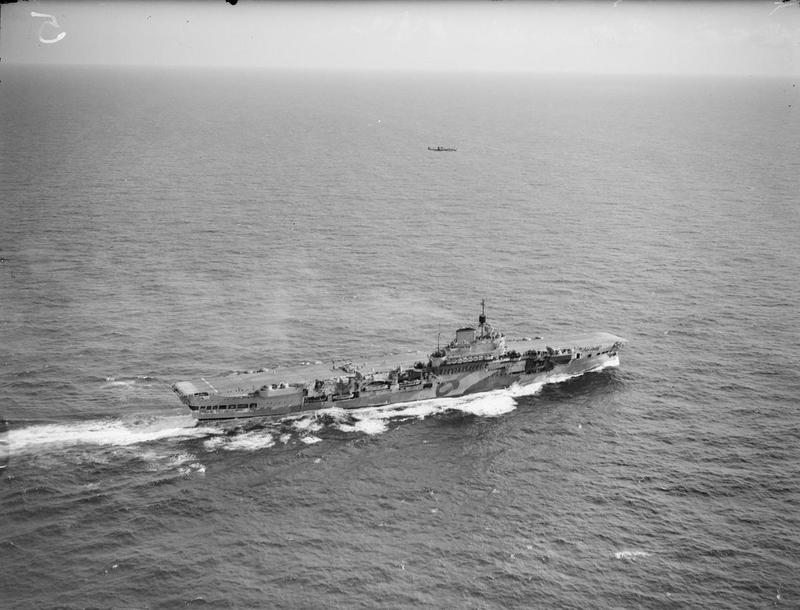
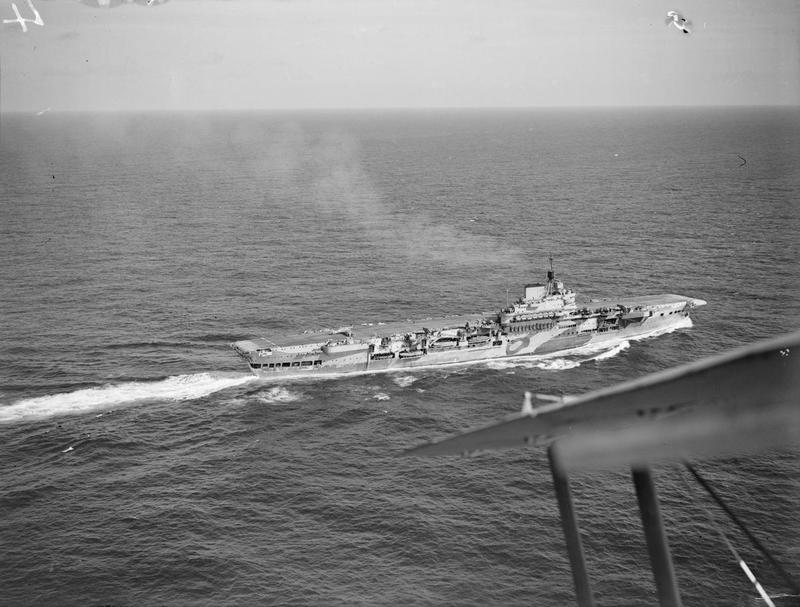
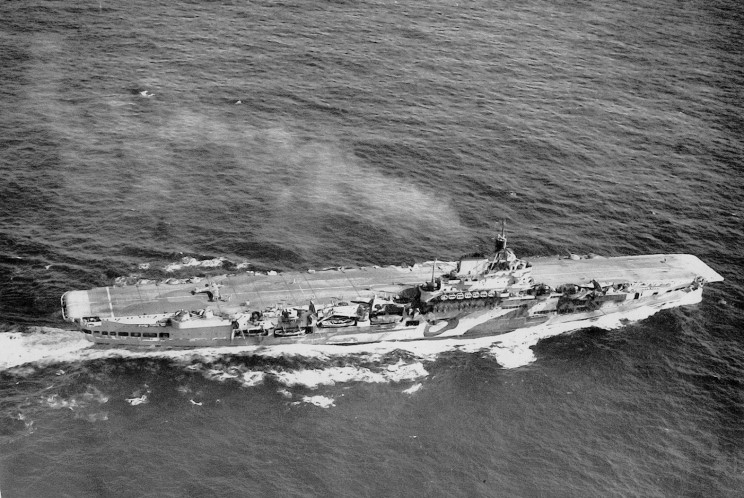
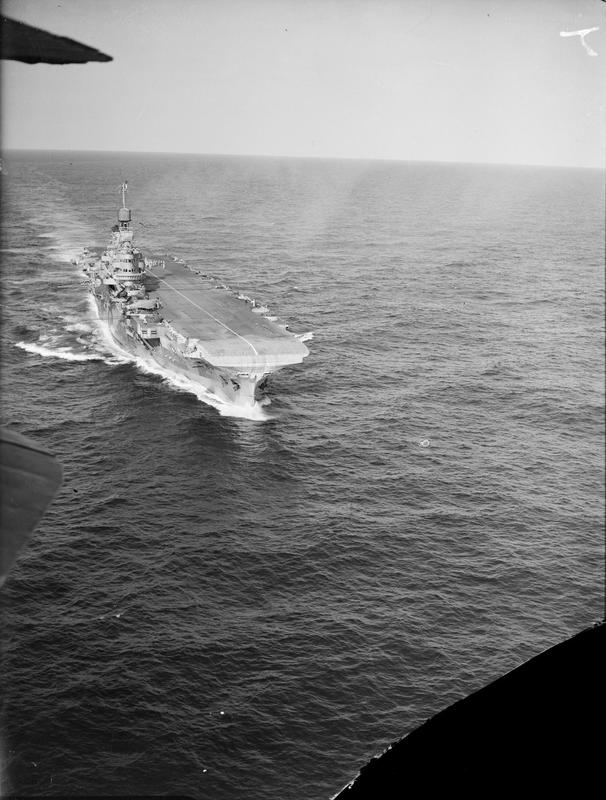
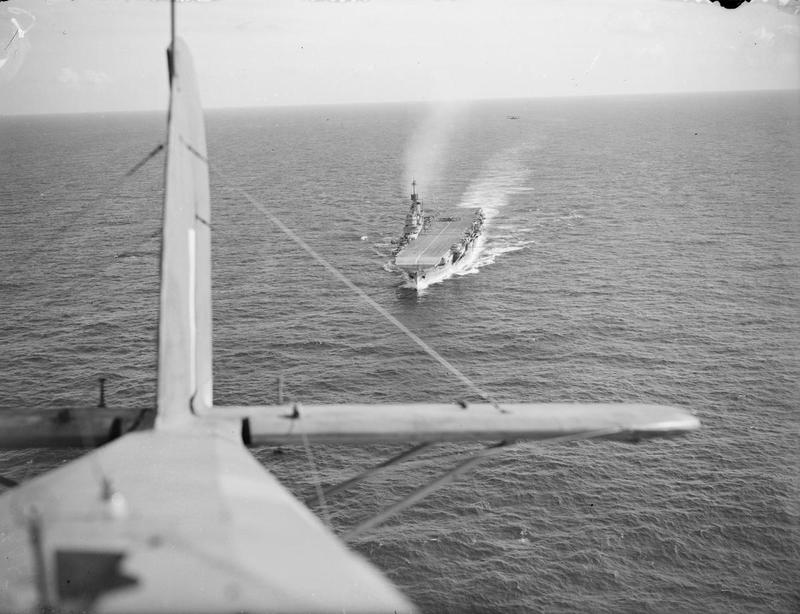

Arrester Gear
Indomitable’s deck arrangement was little changed over her half-sisters. She completed with nine wires aft and two forward.
Because of the repositioning of Indomitable's lifts, the spacing between the arrestor wires had to be reduced from 24ft to 20ft in order to maintain the distance between the final wire and the first crash barrier.
Three crash barriers were fitted amidships, one more than her older sisters.
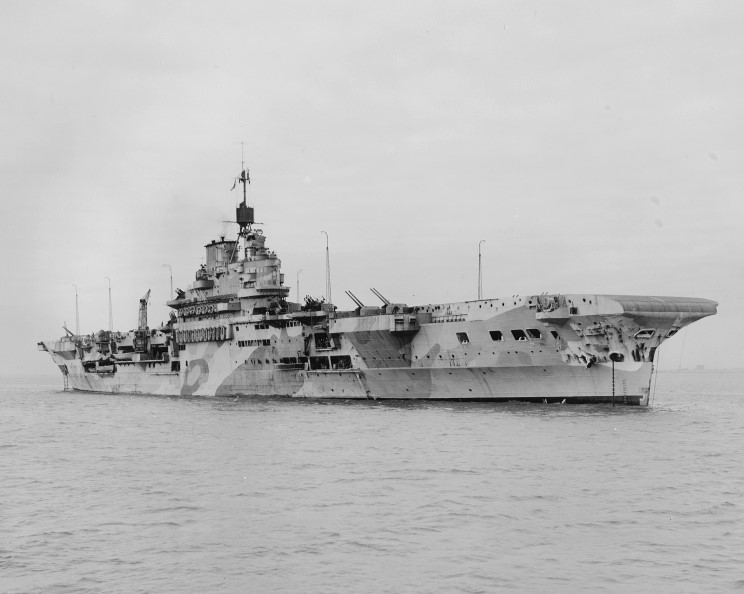
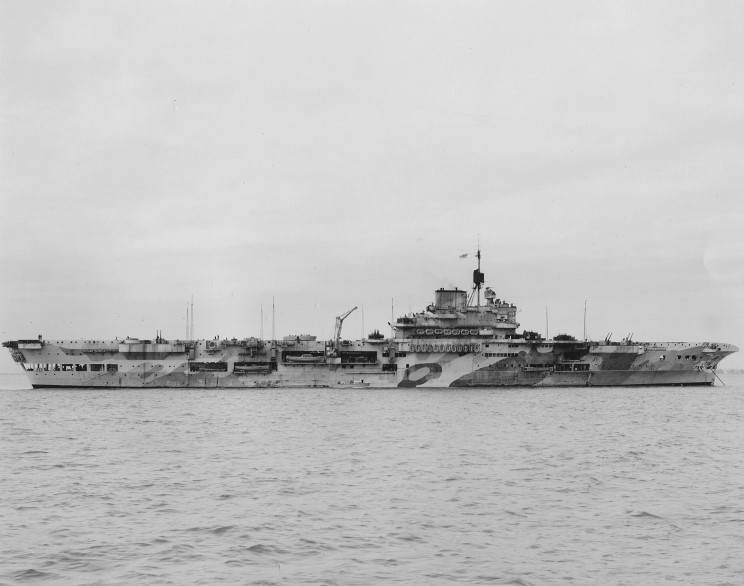
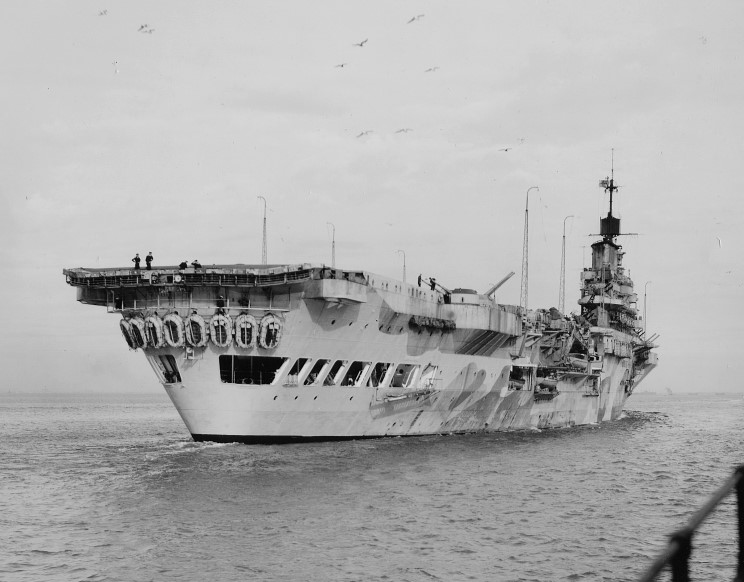
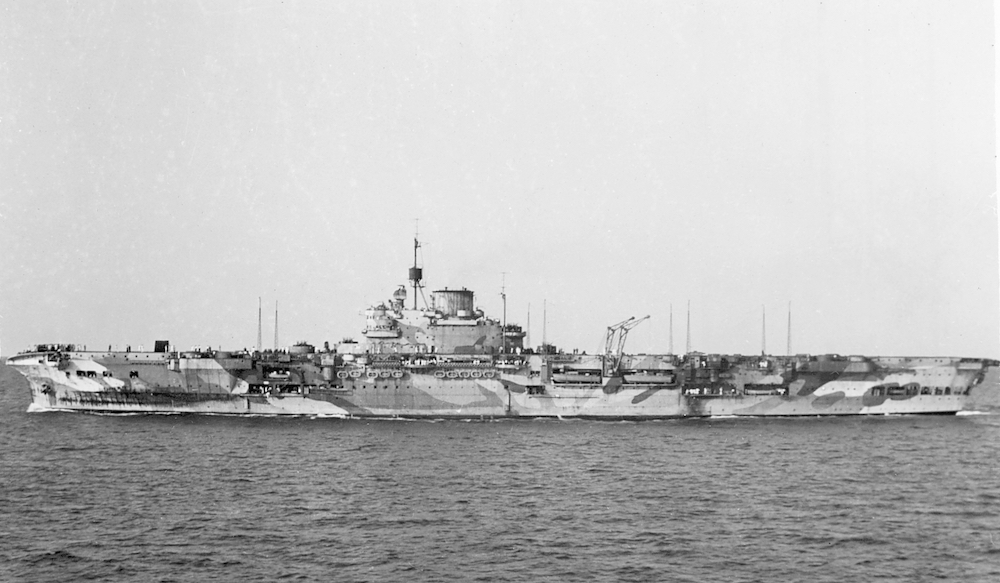
Fuel Stowage, Ordnance
Space needed to be found to fuel and supply the extra aircraft Indomitable carried. Not all of this could be provided by reducing the lower hangar to half length.
As a result 350 tons of furnace oil was sacrificed for space to accommodate 89 tons of petrol.
The discrepancy in stowage capacity is a demonstration of the fuel protection systems incorporated into British carrier designs.
March 30, 1944: HMS Indomitable at the Norfolk Naval Shipyard, Portsmouth, Virginia
Protection
The armoured “box” protection was somewhat reduced in the effort to ensure the ship’s stability along with the new hangar deck.
The hangar sides were reduced to 1.5in face-hardened armour plate.
The armoured flight deck remained the original 3in. But other spaces, such as the lower gallery deck, were changed to 2.5in over the magazines and the lower and upper hangar decks were 1.5in over machinery spaces.
It was argued that in this larger ship, any bombs would have to penetrate both the flight deck armour and the gallery deck before striking the hangar deck.
The bulkheads at the front and rear of the hangars were reduced from 4.5in to 2in.
As Indomitable neared completion it was realised the 1.5in hangar walls would not be sufficient to protect from 500lb bombs.
New aircraft were releasing the bombs at greater velocities. However, there was insufficient time to make the necessary design changes.
A Type 281 antenna (1) and a Type 243 IFF interrogator. The Type 281 air search radar entered service in February 1941 could detect a bomber at 115nm (132 miles, 213km). Specific reported performance was 88-115nm at 16,000ft, 38-50nm for aircraft at 3000ft., 7-9nm for 100ft. Range accuracy was 100yds between 14,000 and 28,000yds, with a bearing accuracy of 1 degree.
HMS Indomitable, 1943: The Type 271 surface-search radar 'lantern' can be seen in front of the bridge windows (1), while the Type 72 aircraft homing beacon is the large drum at the base of the mast (2).
RADAR
While the completion of HMS Illustrious was delayed a month to retrofit new radar equipment, HMS Indomitable was the first of the armoured carriers to receive a full radar suite and dedicated control spaces.
The Type 271 'cheese' antenna, as contained within the protective 'lantern' style perspex protective casing. This first generation centrimetric (S-band) surface-search radar could spot a periscope at 1300yards, and a surfaced submarine at 5000 yards. It was accurate to within 2-3 degrees and 250 yards. Capital ship ranges were about 11nm (12.6 miles, 20km)
Indomitable was initially fitted with the broad-beamed Type 79z and Type 281 search radars, as well as a Type 277 for surface search and low-level aircraft detection and height finding. Type 282 sets were used for anti-aircraft gunnery control, and Type 285 controlled the 4.5in mounts. Plot rooms were soon fitted with a mixture of display types (PPI for the Type 277 and skiatron displays for much of the remainder) which allowed up to 10 plots per minute.
HMS Indomitable also trialed the resoundingly successful prototype vertical plot, fitted in 1943. This, combined with an upgraded radar suite, allowed the FDO to plot up to 12 tracks per minute.
A Type 277 antenna assembly. It was accurate to between 1000 and 2000ft in height finding between 3.5 and 40 degrees of elevation. On a capital ship, it had a range of about 23nm (26.5 miles, 42.5km).
The original Fighter Direction Office had, by 1943, evolved into the Action Information Organisation (AIO). It was divided into three subgroups: The Air Operations room, an Air Direction Room (ADR) and a Radar Filter Room.
The Air Operations centre provided navigation direction for aircraft, both in CAP and ASW missions. It was usually situated on a carrier's upper gallery deck, within the protection of the armoured "box" hangar, but just a few steps from the island.
Unlike the USN Combat Information Centre, the AIO was designed to integrate all the radar offices spread across various ships within the fleet to help cope with a number of simultaneous raids. This was to prove useful off Sakishima Gunto in 1945 where the Japanese employed multiple-approach techniques designed to overwhelm US radar operators. This ability to coordinate the actions of different ships via a dedicated radio channel and command structure drew particular commendation from USN liaison officers.
For example, it was the responsibility of the battleship radar teams to track all friendly patrols via radar and dead-reckoning - thus reducing the strain on the carriers and escorting AA cruisers as they strove to detect and identify hostile movements.
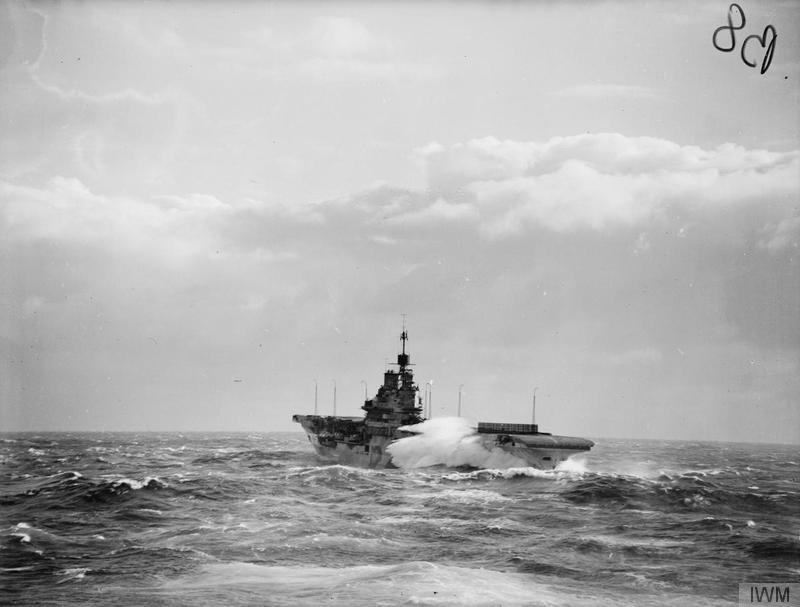

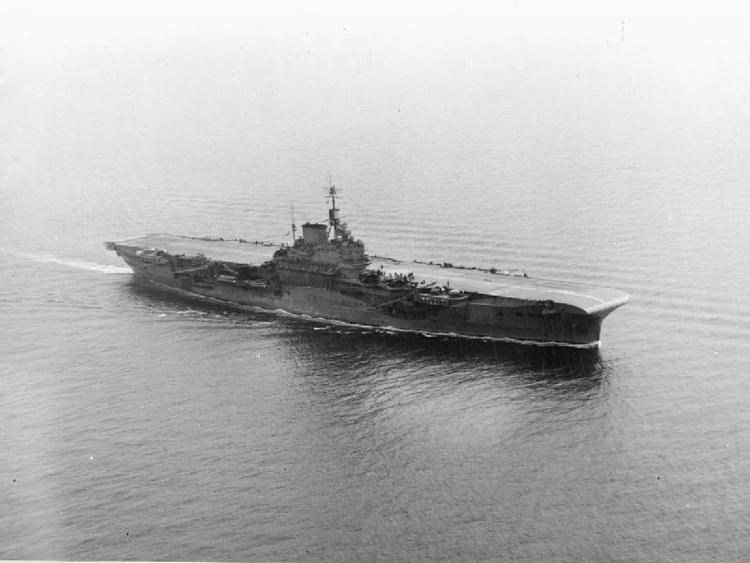
“Only on the Compass Platform, or among the capstans and cables on the enclosed fo’c’sle under the for’ard round-down, on the narrow, cluttered weather-decks or on the quarterdeck with its bell and brightwork and gratings, right aft and far below the flight-deck, where at twenty-six knots the vibration makes one’s teeth chatter, is the ship’s other essence expressed. It is there, nevertheless. For before she is a floating aerodrome, she is a ship, with the beauty of a ship, and a ship’s particular, apprehensible character.”
Machinery
Indomitable’s machinery was little changed over that of her older sisters.
However, the reduction in fuel-oil space did have an impact on endurance. Indomitable had an operational radius of 8200nm at 20 knots, 600nm less than Illustrious.
“The aircraft are parked, almost touching; the Hurricanes in echelon up the starboard side, the Fulmars up the port side, and the Albacores with the whole of the after end to themselves. To prevent them getting adrift, they are chocked fore and aft and lashed down with wire lashings. These are so arranged that it is almost impossible to take more than three steps without tripping over one. The air has a dead, flat taste, and stinks of oil and petrol; and this smell, a sickly, cloying smell, seems to condense on to the metal surfaces of the deck and the aircraft and the tools in a tacky, black film.”
Air Group
It was immediately apparent that HMS Indomitable could carry more than the required 48 aircraft – particularly with a deck park.
Oddly though, despite her two hangars, she was never to carry significantly more than her three older sisters.
In mid 1942, she was carrying 22 non-folding Sea Hurricanes, 21 Fairey Albacores and nine folding Martlet IIs. This compared favourably with the 53 operational aircraft being carried by the USS Yorktown at that time.
In the later war years it was found Corsairs could only be carried in Indomitable's shorter (but taller) lower hangar. None could be stowed in the main 14ft upper hangar.
For this reason HMS Indomitable was to operate the US F6F Hellcat. Her air group while operating in the Pacific during 1945 was made up exclusively of this fighter type and the Avenger bomber.
Excessive demand for accommodation space - given Indomitable was Task Force 57's carrier flagship - saw her lower hangar used as sleeping, office and storage space. This reduced her air group during Operation Iceberg.
Henry "Hank" Adlam: The Disastrous Fall and `Triumphant Rise of the Fleet Air Arm
But an Admiralty-designed large Fleet Carrier provided no such comfort for junior aircrews... Accommodation for the junior aircrews in a Fleet Carrier might typically be on a lower deck, right over the noisy engine shafts at the stern, in single cabins that had been adapted with camp beds to accommodate three young aircrew officers. Such quarters were uncomfortable and noisy so that sleeping properly was difficult ... and yet complaints were never made. I believe it was a sort of RNVR pride not to make a fuss about that poor accommodation...
Such lack of care for young pilots and observers is extraordinary bearing in mind that the sole purpose of the ship and its 1,200 crew was to launch these young men into direct combat with the enemy, either as a striking force or in defence of the ship and the fleet.
Indomitable in April 1944 carrying Hellcats and Avengers.
“The upper hangar ... accommodated thirty aircraft. The lower hangar ... stowed fifteen aircraft. The ship, as designed, therefore carried sixty-five aircraft - forty five in the hangars and twenty in the park on the flight deck.”
Air Group Evolution
HMS Indomitable: April 1942
* Total of 45 aircraft for operations off Ceylon
800 Squadron: 12 Fulmar
880 Squadron: 9 Sea Hurricane
827 Squadron: 12 Albacore
831 Squadron: 12 Albacore
HMS Indomitable: August 1242
* Total of 51 aircraft for Operation Pedestal
800 Squadron: 12 Sea Hurricane I
806 Squadron: 11 Martlet II
880 Squadron: 12 Sea Hurricane I
827 & 821 Squadrons: 16 Albacore
HMS Indomitable: July 1943
* Total of 55 aircraft for Operation Husky
807 Squadron: 12 Seafire LIIC
880 Squadron: 14 Seafire IIC
899 Squadron: 14 Seafire IIC
817 Squadron: 15 Albacore
HMS Indomitable: August 1944
* Total of 48 aircraft for Emmahaven and Indaroeng strikes
1839 Squadron: 12 Hellcat I
1844 Squadron: 12 Hellcat I
815 Squadron: 12 Barracuda II
817 Squadron: 12 Barracuda II
HMS Indomitable: December 1944 & January 1945
* Total of 50 aircraft for Belwan Deli strike & Operation Meridian
1839 Squadron: 15 Hellcat I
1844 Squadron: 14 Hellcat I
857 Squadron: 21 Avenger II
HMS Indomitable: April 1945
* Total of 44 aircraft (rising to 48) as flagship aircraft carriers, BPF, for Operation Iceberg
** A squadron of 12 Fireflies was assigned to Indomitable at this stage, though not shipped: Admiral Vian's staff had reduced available accommodation.
1839 Squadron: 15 Hellcat I&II (17 in Iceberg II)
1844 Squadron: 14 Hellcat I&II (16 in Iceberg II)
857 Squadron: 15 Avenger II
INDOMITABLE identifying features. Higher freeboard than Illustrious, Formidable, Victorious. Rear 4.5in mount sponsons shallower than the similar height IMPLACABLE class. No prominent "tube-like" containers for the forward directors behind the S1 and S2 pom pom mounts. The 4.5in mounts have the slightly raised profile f earlier Illustrious types, not the flush-fitting roof as with the Implacables. The forward lift is wider than the aft lift (which is the same size as both those on the earlier Illustrious-class ships).





